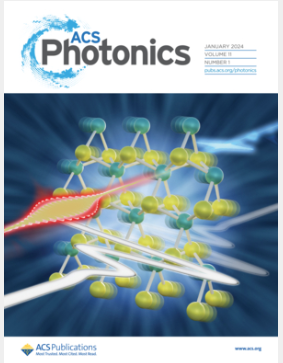纳米激光器之间的相位延迟耦合单模发射
IF 6.5
1区 物理与天体物理
Q1 MATERIALS SCIENCE, MULTIDISCIPLINARY
引用次数: 0
摘要
纳米激光器之间的近场耦合实现了集体高功率激光,但导致复杂的光谱重塑和多模操作,限制了发射亮度、空间相干性和时间稳定性。已经提出了许多基于对称性、拓扑结构或干扰的激光架构来规避这种限制。我们展示了一种更简单和健壮的利用相位延迟耦合的方法,其中激光交换的光携带一个相位,可以实现稳定的单模操作。相位延迟耦合改变了模态放大:对于接近任意子奇偶时间(PT)对称异常点的泵浦功率,高相位延迟完全分离了模式阈值,导致单模工作。用非线性耦合模式理论和随机微分方程对两个耦合纳米激光器进行了稳定性分析,并通过对激光纳米球二聚体的实际半解析处理证实了这一点。最后,我们将模式控制扩展到具有更低阈值和更高功率的大型纳米激光器阵列。我们的工作承诺了一种新的解决方案,可以从纳米激光阵列中设计出明亮和稳定的单模激光,在通信和激光雷达的光子芯片中具有重要应用。本文章由计算机程序翻译,如有差异,请以英文原文为准。

Single-Mode Emission by Phase-Delayed Coupling Between Nanolasers
Near-field coupling between nanolasers enables collective high-power lasing but leads to complex spectral reshaping and multimode operation, limiting the emission brightness, spatial coherence, and temporal stability. Many lasing architectures have been proposed to circumvent this limitation based on symmetries, topology, or interference. We show that a much simpler and robust method exploiting phase-delayed coupling, where light exchanged by the lasers carries a phase, can enable stable single-mode operation. Phase-delayed coupling changes the modal amplification: for pump powers close to the anyonic parity-time (PT) symmetric exceptional point, a high phase delay completely separates the mode thresholds, leading to single-mode operation. This is shown by stability analysis with nonlinear coupled mode theory and stochastic differential equations for two coupled nanolasers and confirmed by a realistic semianalytical treatment of a dimer of lasing nanospheres. Finally, we extend the mode control to large arrays of nanolasers featuring lowered thresholds and higher power. Our work promises a novel solution to engineer bright and stable single-mode lasing from nanolaser arrays with important applications in photonic chips for communication and LIDAR.
求助全文
通过发布文献求助,成功后即可免费获取论文全文。
去求助
来源期刊

ACS Photonics
NANOSCIENCE & NANOTECHNOLOGY-MATERIALS SCIENCE, MULTIDISCIPLINARY
CiteScore
11.90
自引率
5.70%
发文量
438
审稿时长
2.3 months
期刊介绍:
Published as soon as accepted and summarized in monthly issues, ACS Photonics will publish Research Articles, Letters, Perspectives, and Reviews, to encompass the full scope of published research in this field.
 求助内容:
求助内容: 应助结果提醒方式:
应助结果提醒方式:


